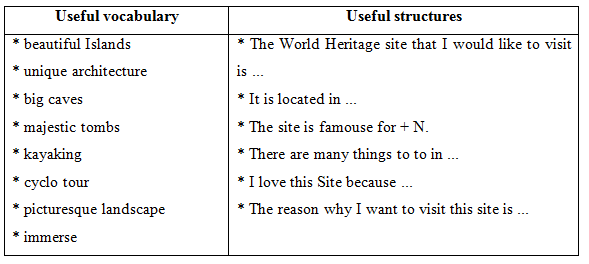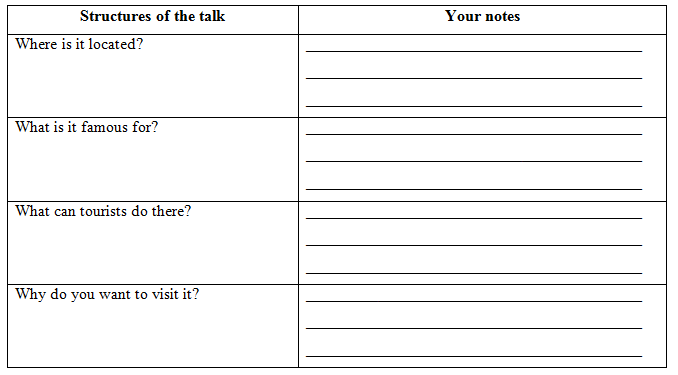Read the passage and choose the best answer to each of the following questions.
In 1959, the government of Egypt was working on a plan to build a dam on the River Nile. It was called the Aswan Dam, and it was intended to generate electricity and allow the river water to be used for agriculture. There was one big problem with the plan, though. The dam would flood a nearby valley that contained ancient Egyptian treasures, including two enormous stone temples.
It can be difficult for governments to choose culture and history over economics. However, if countries always made decisions like this, the majority of the world’s ancient sites would end up being destroyed. Luckily, UNESCO stepped in. They formed a committee that tried to convince Egypt to protect its ancient treasures. With support from many countries, they were finally successful. The huge temples were carefully removed from their original site and moved to a safe location so that the dam could be built.
After their success in saving the temples in Egypt, UNESCO went on to save more sites around the world. They protected lagoons in Venice, ruins in Pakistan, and temples in Indonesia. With industrialization changing the world rapidly, there were many sites that needed to be saved. Eventually, UNESCO formed the World Heritage Organization to protect Important natural and historic sites wherever it was necessary.
(http://www. englishdaily626. com)
1. What Is the best title for the passage?
 Giải bởi Vietjack
Giải bởi Vietjack
Dịch nghĩa toàn bài:
Năm 1959, chính phủ Ai Cập lập kế hoạch xây dựng một con đập trên sông Nile gọi là đập Aswan. Theo dự kiến, con đập này sẽ được sử dụng để phát điện và cung cấp nước tưới cho nông nghiệp. Tuy nhiên, kế hoạch này gây ra một rắc rối lớn. Con đập sẽ làm ngập một thung lũng gần đó chứa kho báu của người Ai Cập cổ đại, bao gồm hai ngôi đền đá khổng lồ.
Chính phủ Ai cập sẽ khó mà có thể hy sinh lợi ích kinh tế để bảo vệ giá trị văn hóa và lịch sử. Tuy nhiên, nếu các quốc gia luôn đưa ra những quyết định tương tự như vậy thì phần lớn các di sản cổ xưa trên thế giới sẽ bị phá hủy. May mắn thay, UNESCO đã có sự can thiệp. Họ đã thành lập một ủy ban nhằm cố gắng thuyết phục chính phủ Ai Cập bảo vệ kho báu cổ xưa của mình. Với sự hỗ trợ từ nhiều quốc gia, cuối cùng họ đã thành công. Những ngôi đền khổng lồ đã được gỡ bỏ khỏi vị trí ban đầu một cách cẩn thận để lấy chỗ xây dựng con đập và được chuyển đến một vị trí an toàn khác
Sau thành công trong việc giữ lại các ngôi đền ở Ai Cập, UNESCO đã tiếp tục giải cứu nhiều địa điểm khác trên khắp thế giới. Họ đã bảo vệ đầm phá ở Venice, các tàn tích ở Pakistan và đền thờ ở In-đô-nê-xia. Thế giới đang thay đổi nhanh chóng do ảnh hưởng của quá trình công nghiệp hóa. Vì vậy, có rất nhiều các di sản cần phải được bảo vệ. Cuối cùng, UNESCO đã thành lập Tổ chức Di sản Thế giới để bảo vệ các di tích thiên nhiên và di tích lịch sử quan trọng ở bất cứ nơi nào cần thiết.
Đáp án: D. UNESCO to rescue
Dịch nghĩa câu hỏi: Tiêu đề tốt nhất của bài đọc là gì?
A. UNESCO B. UNESCO thành công
C. UNESCO phát triển D. UNESCO giải cứu
Giải thích: Bài đọc này nói về việc UNESCO đã giải cứu thành công di sản của người Ai Cập trong một thung lũng bên bờ sông Nile và sau đó tiếp tục giải cứu nhiều di sản khác trên toàn thế giới. Vì vậy, đáp án phù hợp nhất là D.
Gói VIP thi online tại VietJack (chỉ 400k/1 năm học), luyện tập gần 1 triệu câu hỏi có đáp án chi tiết
12. Penryn itself is unspoilt, and its old and narrow streets are under a__________order.
14. The relics__________include jewellery, seeds, animal bones and pottery like these human figurines
Write an essay about one of the World Heritage Sites in Vietnam.
You can use the following questions as cues:
• Where is it located?
• What are its special features?
• What can tourists do there?
• Would you like to visit Hoi An Ancient Town? Why?
__________________________________________________________________
__________________________________________________________________
__________________________________________________________________
__________________________________________________________________
7. The 13 rings of the spire symbolizes the 13 steps of the ladder__________to Nirvana.
9. The Bhaktapur Durbar square, also__________as Bhadgaon, consists of at least four distinct squares.
24. Taj Mahal is the second World Heritage site__________under the campaign which will be carried out by ONGC at this monument.
2. We passed rocky beaches, secret inlets, muddy coves, dark hidden sea__________pounded by surf.
5. Lack of rainfall means that they have survived__________for hundreds of years, though they are now being threatened by tourists.
Talk about one of the World Heritage Sites you would like to visit. You can use the following questions as cues:
* Where is it located?
* What is it famous for?
* What can tourists do there?
* Why do you want to visit it?
Useful languages:

Complete the notes:

Now you try!
Give your answer using the following cues. You should speak for 1-2 minutes.
1. The World Heritage site that I would like to visit is ... It is located in ...
2. The site is famouse for + N.
3. There are many things to to in ...
4. I love this site because ...
Now you tick!
Did you ...
- answer all the questions in the task?
- give some details to each main point?
- speak slowly and fluently with only some hesitation?
- use vocabulary wide enough to talk about the topic?
- use various sentence structures (simple, compound, complex) accurately?
q pronounce correctly (vowels, consonants, stress, intonation)?
Let’s compare!
Finally, compare with the sample answer on page 171.
Read the passage and decide whether theses statements are True (T) or False (F).
Located in the heart of the Phong Nha-Ke Bang National Park, Son Doong cave, which is more than 200 metres in width, 150 metres in height and approximately 6.8 kilometres in length, was explored by the British Cave Research Association during 2009-2010 and it has been open to the public since 2013. st is believed to have been formed 2-5 million years ago. Son Doong Cave has been recognised as the largest of its kind in the world by three international record-keeping organisations - Guinness, the Association World, and WorldKings. Holding important scientific values, in terms of geology, geomorphology and ancient climate, the cave has been favoured by many scientists and science channels worldwide. The eco-system inside Son Doong is unique as it is large, and it even has its own localized weather system. Rare limestone cave pearls are scattered in dried pools, and the largest stalagmite ever found stands 80 meters tall. According to an initial study from the Vietnam Academy of Science and Technology, besides 161 species of flora found inside Son Doong, the cave is home to 300-million-year-old coral fossils which are valuable for the analysis of geological layer changes through times.
(Nhan Dan Online, 2019)
1. Son Doong cave is located next to Phong Nha Ke Bang National Park.
4. Hoi An Ancient town, __________in Viet Nam’s central Quang Nam Province, comprises 30 ha and it has a buffer zone of 280 ha.
Listen and fill in the blanks with ONE appropriate words.
A group of scientists announced Thursday what they say is the discovery of remains from an early (1)___________of human beings. Bones from the species were found two years ago inside a (2) ___________at a United Nations World Heritage Site, near Johannesburg, South Africa. The South African government has named the area the cradle of Humankind because of its rich collection of ancient human-like (3) ___________.
The scientists are calling the new species, ‘Homo naledi’. The word naledi means (4) ___________ in South Africa’s Sesotho language. The scientists reported that about (5) ___________bones have been recovered from the cave. They said the bones come from at least 15 individuals. The team reported its findings in the journal eLIFE.
Lead scientist Lee Berger works at the University of Witwatersrand. He said the discovery “was right under our nose in the most explored valley of the continent of Africa.” Mr. Berger spoke to reporters Thursday in Johannesburg.
10. The Patan Durbar Square, __________in the 3rd century, is situated only 8 km south-east of Kathmandu city.
5. Crespi D’Adda, which features a school, clinic, theater, and sports center together with residential buildings today, served to be a town for workers of a textile manufacturing company.
→ _______________________________________________________________________1. The Chitwan National Park, which was granted the status of World Heritage site in 1984, is the first national park in Nepal.
→ _______________________________________________________________________